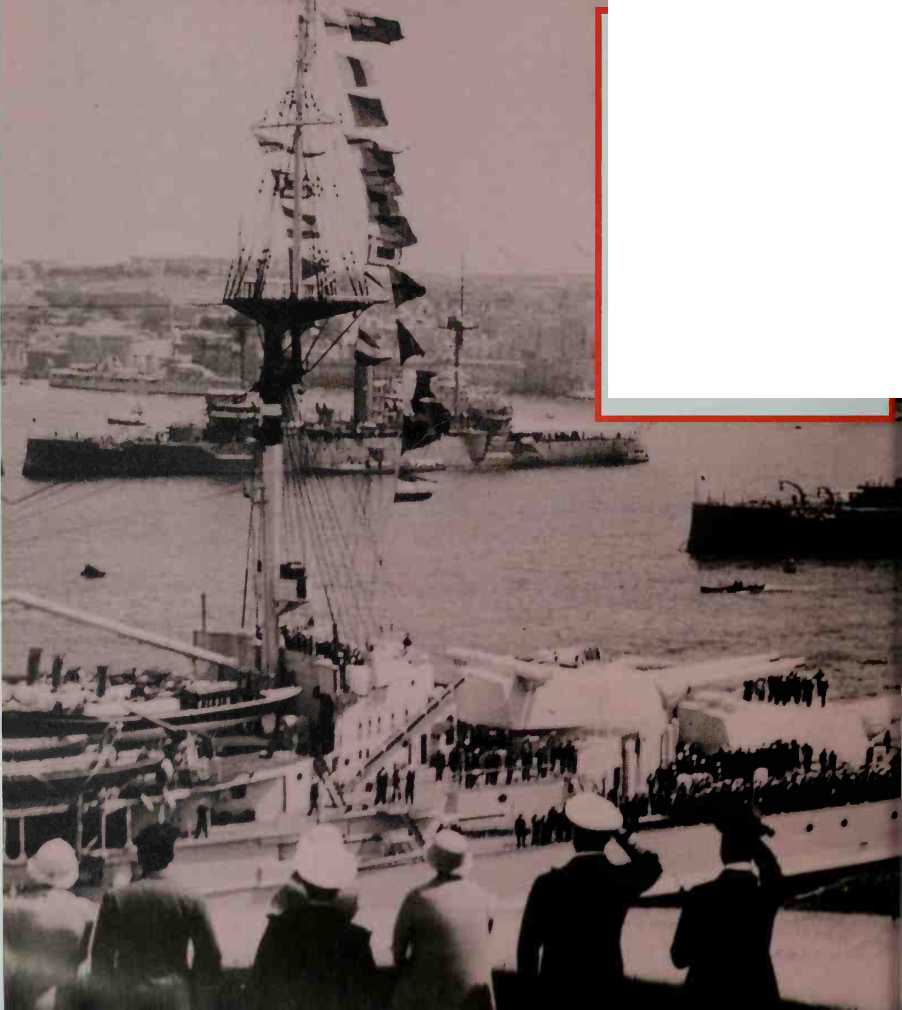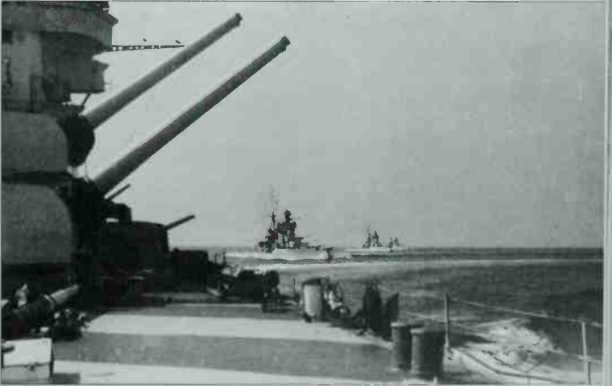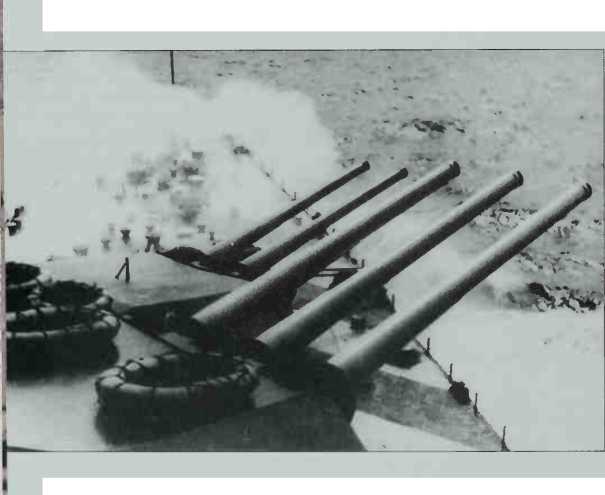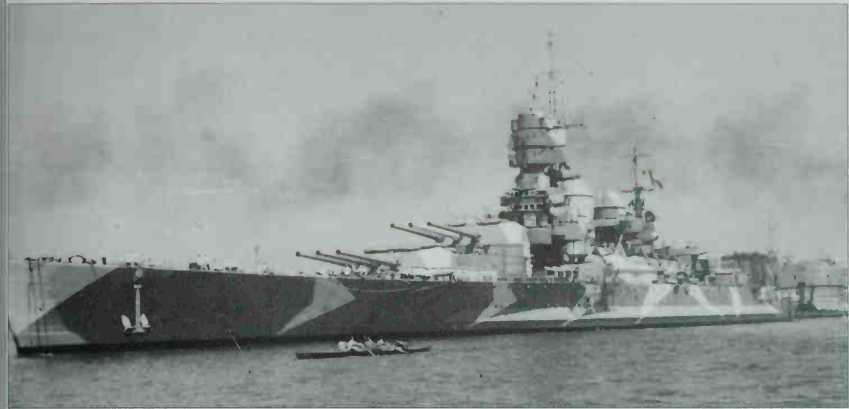
Jostling for pole position in the Mediterranean, the tussle between the Italian and British navies was set to be of epic proportions. In the event, the British navy pulled off a tactical masterstroke which decided the debate before Italy marked its first anniversary at war.

Above: Italian cruisers Flume, Gorizia and Pols undergoing manoeuvres.
Lett: HMS Revenge sets sail from Malta In 1939, before the siege.
Britain had its own Mediterranean fleet. Key bases for Britain were Gibraltar, at the teeth of the Mediterranean, the hard-pressed island of Malta and Alexandria, the Egyptian port operating under Admiral Sir Andrew Cunningham, from which supplies were being shipped to Greece.
Italy had well-established ports of its home territory opening into the Mediterranean and the Aegean as well as control of Albania and Ubya, on the northern coast of Africa.
When war broke out, the British had a grasp of Italian naval codes and gathered enough information to sink nine Italian submarines before the end of June 1940. But a fortuitous switch in cipher systems by the Italians in July prevented the British from cracking the codes again.
The Italian air force wasted no time in bombing the British big ships when they were at sea. Italian intelligence about British sea traffic was
The Italian air force wasted no time in bombing the British big ships
Good. It enabled her captains to circumnavigate all convoys to Libya around the British forces.
Against this background, Cunningham was determined to punish his Italian enemies and put to sea 16 times between June and October 1940. Yet he only managed to track Mussolini’s ships three times.
So it was a priceless morale booster for the British when, on I I November 1940, the Fleet Air Arm attacked Taranto, an Italian port. In port were six Italian battleships. A dozen Swordfish aircraft from the aircraft carrier Illustrious took off at dusk and flew 170 miles to deal the blow to the Italian navy vessels, struggling to gain height with their heavy load of explosives.
They notched up two strikes with hits against the battleships Cavour and l. ittorio. A second wave of Swordfish arrived less than an hour afterwards, directed to their target by the blaze now roaring at the base. Together, they damaged the battleship Duilio. At a cost of two aircraft, the Italian fleet was deprived of three valuable battleships - Cavour permanently; l. ittorio and Duilio until the late spring of 1941.
The Italian navy was still a force to be reckoned with, however. Admiral Cunningham was determined the threat they posed to Allied shipping in the Mediterranean should be rubbed out.
At the turn of the year, Fliegerko-rps X, the I. uftwatle’s anti-shipping force, transferred 200 of its aircraft to Sicily. By 10 January 194 1 bombers from the precision corps landed six bombs on Illustrious and also struck Warspite, although neither ship was terminally damaged.
It demonstrated, however, the need for air sCiperiority if the Allies were to control the. Mediterranean. Unfortunately, there was a shortage of Allied aircraft in the area, worsened when the Illustrious was hit again while in dock at Malta. Air attacks against Malta were so heavy and so frequent that it proved impossible to carry out adequate repairs to the much-needed aircraft carrier there. Consequently she had to be withdrawn from the. Mediterranean.
¦ ITALIAN THREAT ¦
The British resolve to eradicate the Italian naval threat hardened and its objective was carried out in spectacular fashion, off Cape Matapan, the most southerly point of Greece. On 27 March 1941, a British reconais-sance plane spotted a large gathering
Below: The big guns of the Vittorio Veneto unleash their fire power.

DAKAR DEBACLE
Among the military calamities faced by Britain in the first half of the war was the debacle of Dakar. British ships sailed to the colony of French West Africa with the aim of landing Free French Forces who would wrest control from the Vichy regime.
As they anchored off the main port of Dakar on 23 September 1940, General de Gaulle broadcast a series of messages to the colony’s governor stating his intention to land troops. All of the messages were ignored. Five messengers sent ashore with similar news were likewise rebuffed.
De Gaulle began threatening to use force. In reply, the coastal guns and ships at anchor in the port let off a barrage at the British ships, preventing the planned landing.
The next day the exchange of fire continued with the British battleship Barham being struck. Twenty four hours later the battleship Resolution was hit, this time sustaining more serious damage.
At this the British commanders and de Gaulle realised that their carefully laid plans to steal a march on Vichy France was quite literally being shot to pieces. Consequently, the ships pulled out of the engagement and returned humiliated to Freetown, the capital of Sierra Leone. Apart from the damage to its ships, the British also had to endure a reprisal air raid by the leaders of Vichy France directed against Gibraltar.
Of Italian ships. The squadron comprised eight cruisers, the prestige battleship Vittorio Veneto and a host of destroyers. Vittorio Veneto was the pride of the Italian fleet now her sister ship Littorio had been holed by the British at Taranto. Now she was poised with her support vessels to blow convoys destined for Greece out of the water.
Cunningham was instantly informed at his base in Alexandria. To back the aircraft sighting there were messages passed through the Italian secret service cipher which had been broken by the Allies. He grouped together three battleships, the aircraft carrier Formidable, four cruisers and as many destroyers as he could muster. If trouble was coming, the Royal Navy together with its Australian contingent were prepared.
Admiral Cunningham then made a move to protect the secrecy of the British activities which has since gone down as wartime folklore. A keen golfer, he played regularly in the same club in Alexandria as the Japanese consul who reported every move made by the British Mediterranean Fleet to its enemies. Not only did Cunningham take his clubs to play golf that afternoon but ostentatiously carried a suitcase, clearly bound for a night ashore. Having duped the tell-tale consul, he abandoned the case and slipped back aboard the battleship Warspite in time for an evening departure. Fortunately, the British ships did not pull out until after the Italians had carried out aerial reconnaissance of Alexandria harbour which revealed all were still at anchor. Italian Admiral lachino was satisfied the British posed no danger.
The two forces, both travelling in independent groups, first clashed in the morning of 28 March. After 40 minutes of exchanging shells, neither
The British launched wave after wave of aircraft to pester the Italians
Side had scored a hit and the action was broken off. The British launched wave after wave of aircraft to pester the Italians who were themselves left virtually completely unprotected by their own air forces - which were stationed in easy range.

Above: Vittorio Veneto was the jewel in the Italian navy crown.
Vittorio Veneto was hit by one torpedo but still managed to escape the ravages of the air bombardment. However the cruiser Pola was stopped in her tracks by British firepower. lachino, who was without the benefit of radar and still apparently oblivious to the presence of British big ships, ordered two other cruisers to assist her. That night all three were attacked at short range. Two were quickly sunk without firing a shot. I’ola and two other vessels were also sent to the bottom.
The British ships in the vicinity picked up 900 survivors before being scared off by the arrival of Luftwaffe planes. A further 270 men were plucked from the sea in the subsequent days but still the Italian casualties amounted to a devastating 2,400. The Battle of Matapan had been the biggest naval engagement of the war so far and dealt a serious blow to the Italian navy.
Vittorio Veneto was not to escape for long. A British submarine torpedoed her again in December 1941.
Despite the inferiority of Allied air cover, the Royal Navy continued to carry out admirable harrassing manoeuvres against the Italians and the Germans in the Mediterranean. Most notable were the contributions made by the cruisers Aurora and Penelope operating out of Malta who targeted convoys destined for Libya with immense success. Hitler and Mussolini were counting the cost of the contribution to the North African campaign made by the small island.
But the British didn’t have it all their own way. When U-boats arrived in the Mediterranean, the fleet was deprived of the aircraft carrier Ark Royal which was sunk in November 1941, as well as the battleship Barham and two cruisers.
If the Italian navy was down, it certainly was not out as its attacks against British ships berthed in the harbour at Alexandria m December 1941 amply illustrated.
In the naval armoury were minute submarines, nick-named ‘pigs’ by their crew who were clad in frogmen’s suits and sat astride the 22ft long craft. The ‘pigs' were carried close to their position by regular submarines. Then it was the job of the crew to go in close to the target and attach timed explosives.
The Italians had made two abortive attempts using ‘pigs’ against the British during August and September 1940. This time there were to be no mistakes.




 World History
World History









